

Is every task in your pipeline equally urgent?
Do you make a simple to-do list and knock out each task from start to finish?
Well, if so—that’s a big red flag.
Why?
If you’re not actually prioritizing tasks, it’s just a matter of time until you become a chronic project bottleneck. When you don’t know how to prioritize projects based on you or your teams’ productivity, it can greatly harm your overall work.
Without any hierarchy in your tasks, you go against the grain of your team management skills, which only leads to unhealthy team environments. If your team can’t trust you to address the most urgent tasks, they’ll likely avoid asking you for help.
All that will do is create project chaos.
So, maybe we completely steer clear of that scenario and learn the best ways to prioritize tasks. This is your guide to better focus on the most critical tasks first, inspire trust in your team, and avoid missed deadlines.

- 8 Steps to Prioritizing Tasks at Work
- 1. List your tasks in no particular hierarchy
- 2. Indentify which tasks you should do first
- 3. Keep adjusting your priorities
- 4. Realistically estimate your effort into task completion
- 5. Recognize your productivity limits and keep work life balance in mind
- 6. Schedule all of your tasks and work assignments
- 7. Block your time to get more work done
- 8. Communicate with your team as needed
- 3 Time-Saving Work Prioritization Templates
- Start Prioritizing Tasks to Optimize Your Workflow
8 Steps to Prioritizing Tasks at Work
Knowing what tasks can be addressed now or later will influence the success if your project. From employee disengagement and absenteeism to low performance and productivity, inefficient task prioritization affects large and complex projects.
And in the end, your company’s bottom line depends on it. That’s why you must understand how to prioritize tasks to manage your time and define urgency amongst your team.
If your team believes you’ll simply complete tasks because you’re their manager, team communication has already started to disintegrate. Prioritizing tasks is crucial for high-performing teams, but what can you do to address it?
1. List your tasks in no particular hierarchy
To start with, write down a list of all your tasks. Include both ongoing and future tasks for all your projects in this to-do list. And don’t leave any of them outside the to-do list for any reason.

This might sound dispensable. However, prioritizing and managing tasks effectively in our heads is an illusion. Sure, it’s feasible for small, one-person projects, but it’d be a saga for most projects.
You must have the full picture of all your in-progress, scheduled, and yet-to-start tasks in a single place outside your head. And for some, in needs to be unordered so you’re not just going down a list or treating all tasks the same.
Instead, try to prioritize tasks and communicate the priorities to your team. And that’s how you enable workload management and get a sense of your priority list so you can redistribute it if needed.
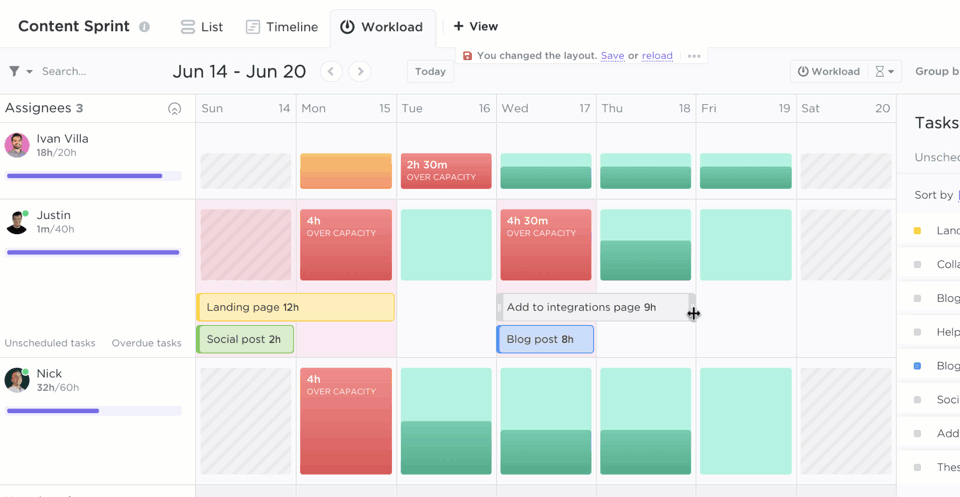
ALWAYS START WITH CREATING YOUR LIST FIRST
Don’t try to skip the task to-do list step to speed things up! That’s a trap. And you won’t be able to avoid all the high costs of lacking task prioritization we already discussed. Break down bigger tasks into subtasks. This simplifies the next steps, and in task management software like ClickUp, you can even rearrange or edit subtasks in bulk.
There’s no need to order the tasks in the list right now. But this is excellent timing for grouping them by day, week, month, and year. And the same goes for adding a duration and due date to each task.
Beware that tasks don’t comprise only work on project deliverables. They’re also meetings, phone and video calls, presentations, and answering instant messages and emails. But usually, these are steps within tasks.
To compile your task list, use pen and paper or ClickUp. But let us tell you something: Using a tool streamlines the endless job of updating the list as new tasks come up. And this task prioritization and time management method could save a ton of time.
Organize tasks with Taskade alternatives!
2. Indentify which tasks you should do first
We all feel compelled to do small, easy, quick tasks first, regardless of their priority. That’s our completion bias kicking in. Plus, studies show our brain releases dopamine into the bloodstream whenever we finish important tasks, which gets us hooked to keep doing it.
But you must fight that back! And you can do it by:
Distinguish important from urgent tasks
What’s an important task? And what’s an urgent task?
Undoubtedly, an important task that’s not urgent must be on your task list. You must schedule the task, but you don’t need to execute it right away. You can actually postpone the task.
On the other hand, you must perform urgent and important tasks today or in the next few hours. But they aren’t necessarily important tasks, so you might delegate them for someone else execute them.
Then, you likely have other tasks that are both important and urgent. You must do them immediately to avoid serious negative impacts, such as missing a client deadline, losing a client contract, not launching a product, or not releasing a service.
Finally, some of your daily tasks are neither important nor urgent. This means you might remove those from your task list without causing any negative impact on the team, department, or whole company.
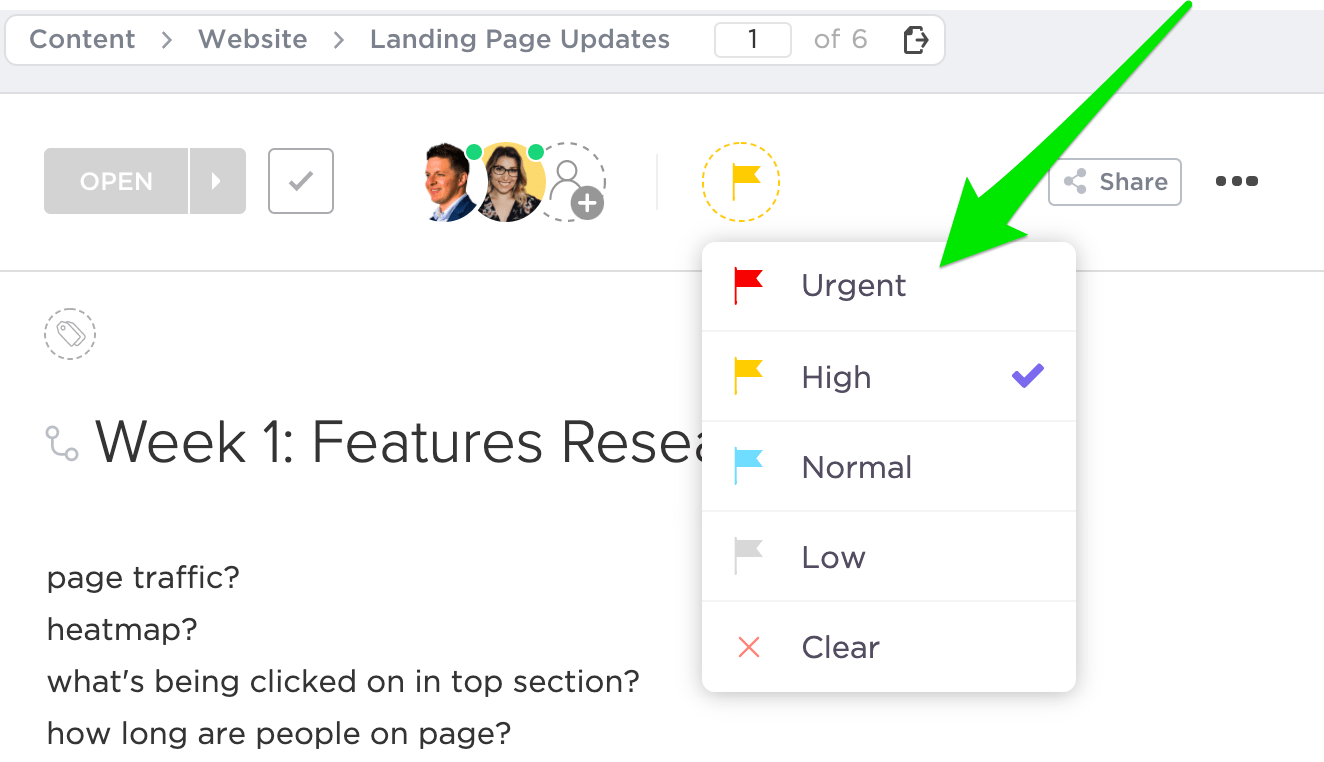
ClickUp allows you to add custom tags to tasks to mark them as important, urgent, both, or none. Additionally, all tasks can be set to specific priorities like urgent, high, normal, and low.
Order tasks by their value
Which of your tasks bring a high value to the business? Those tasks are priorities, but not all of them are critical.
Their priority depends on their value. Critical tasks are urgent and high in value. High-priority tasks aren’t urgent, yet they bring high value to the business. Medium-priority tasks are urgent but low in value. Lastly, low-priority tasks are non-urgent and low-value.
Here are a few examples of tasks with high value to any business:
- Doing client project work (over internal project work)
- Fixing access to the corporate videoconferencing platform of a remote-only company (before searching for a higher-quality alternative)
- Answering client support tickets (instead of redesigning your website)
- Describing the requirements of the new product your team will build (as opposed to a task the team doesn’t depend on)
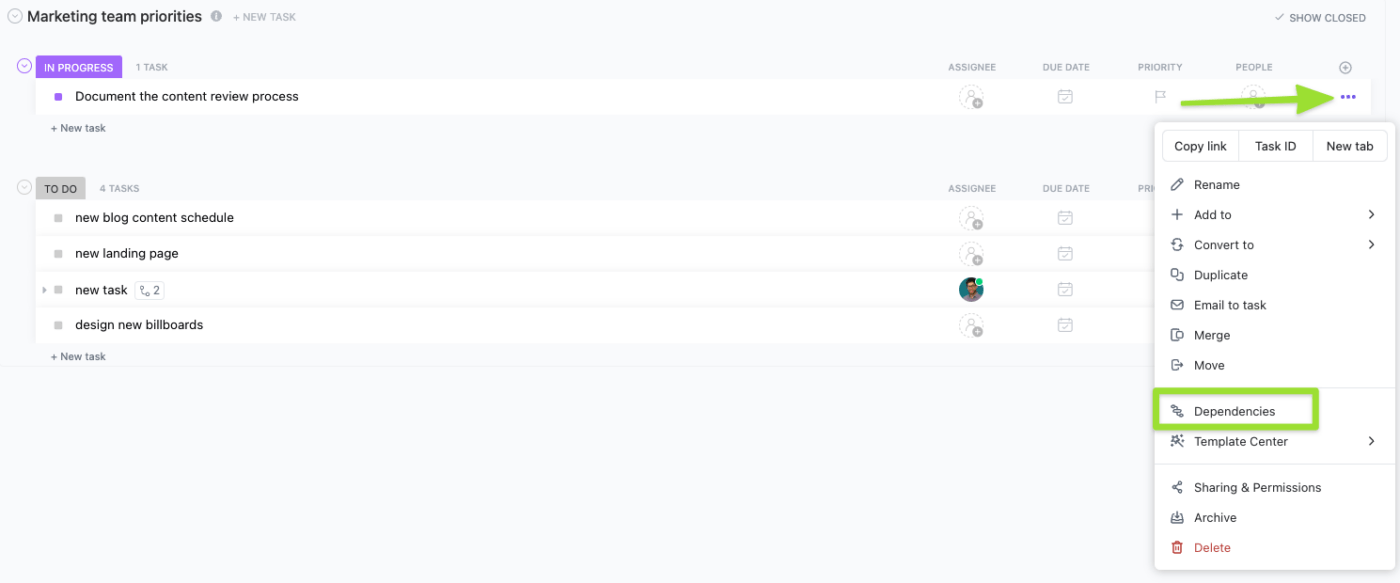
Create relationships between your tasks and your team in ClickUp to navigate across each task and check the status with ease. Additionally, you can use ClickUp to set dependencies for tasks and ultimately establish the order of their execution.
Rank important tasks by effort
If you want to set your day up for productivity, then rely on effort estimates. This means you must complete the highest-effort task first before doing anything else each day.
Highest-effort tasks are often the more complex tasks of the day or those strongly associated with the company’s OKRs. Tackling them first thing each day drastically reduces your level of stress while creating momentum and boosting motivation.
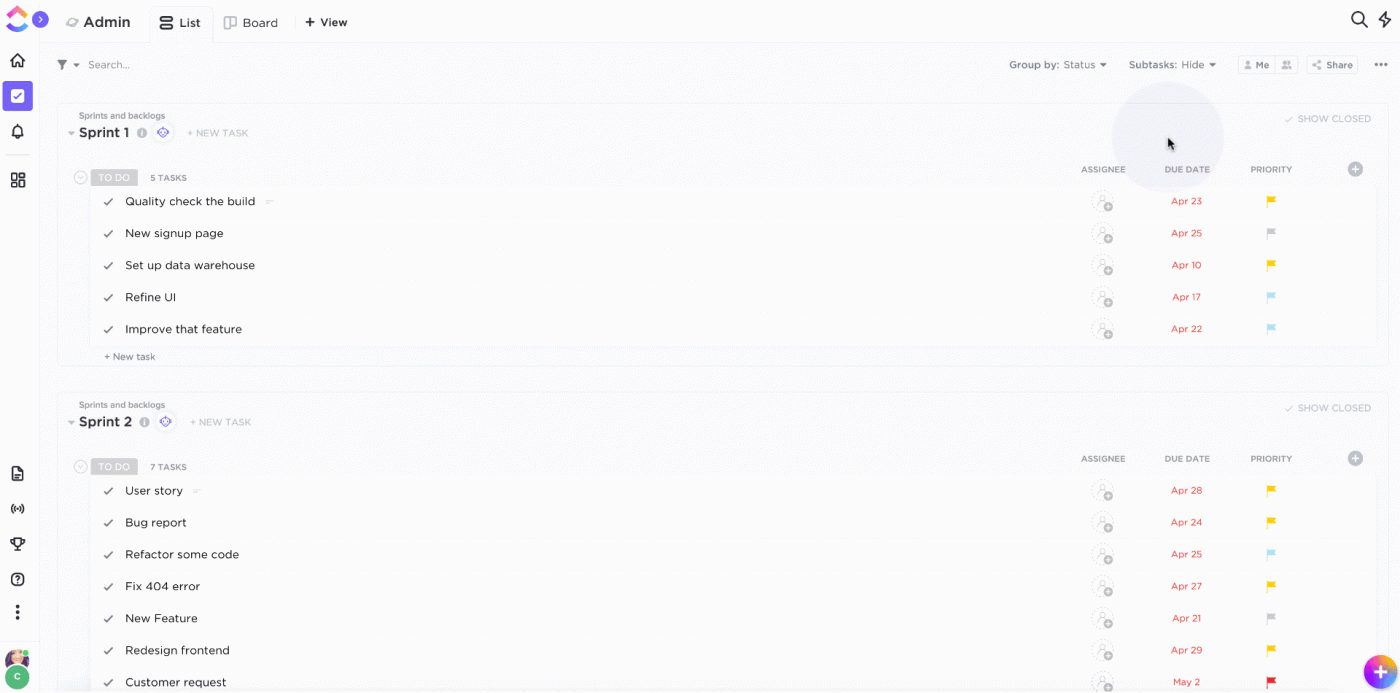
With the help of ClickUp, it’s easy to add custom fields with a “Number” value to evaluate and determine the estimated work to each task on a number basis (i.e., 1-5 with 5 being hardest). This process is used in scrum project management, but it can work similarly for your team too!
Define priorities for the day
You probably plan important tasks for long periods, such as weeks or even years. But this method helps you approach your task plan for the week day by day:
- Before you call it a day, select the most important tasks you must do the day after (six, tops)
- Prioritize tasks based on their importance
- The day after, focus on the first task on the list and don’t move on to the next task before finishing that one, and so on
- At the end of the day, move the unfinished work to the next day’s list—whether it’s one task or several—and repeat the whole process
3. Keep adjusting your priorities
If you want to learn a way around task prioritization, being adaptable is something you’ve got to master. Because you never know when a change order or an unexpected problem with the team, business, or product will come up.
But you can prepare yourself for unpredictable events that shift task priorities. Develop a task prioritization review habit and set up a system not to forget to do it rather frequently.
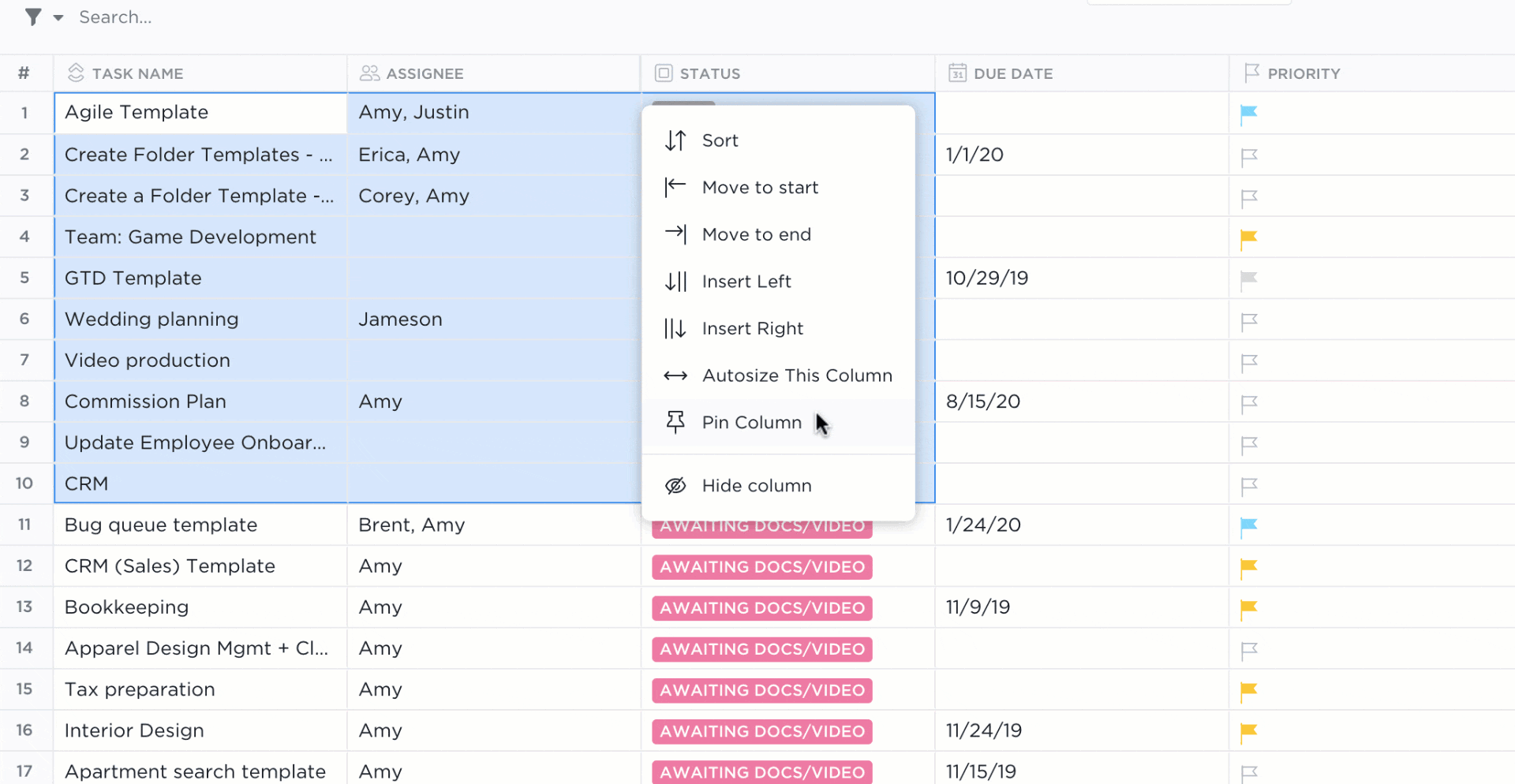
Review task priorities every day at the beginning or end of the day. But if you prefer, do it on Friday afternoon for the following week and review the priorities by the end of each day.
AVOID THE CONTINUOS TIME WASTERS
Time management skills are a major key to prioritizing your tasks. Drop a task that suddenly stopped being a priority, even if you feel like finishing it and have already put a lot of time and effort into it. It’d be a waste of time and might compromise a deadline to keep doing a task that’s not a priority, especially when some other task became the priority.
4. Realistically estimate your effort into task completion
Are your effort estimates backed up by a track record of task completion times? Well, if not, you must start tracking those times because you’ll need them even if you haven’t prioritized tasks by effort.
Track the time to complete your tasks with ClickUp’s project time-tracking software. Afterward, refine your effort estimates based on that record.
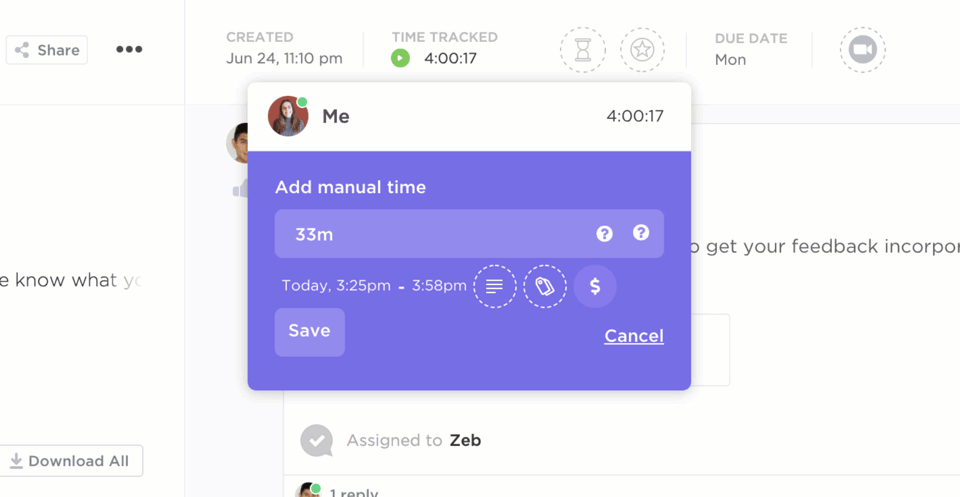
You need to allocate resources based on different criteria and more likely than not, one area will be time spent on tasks.
The last thing you want to do is make unrealistic effort and time estimates for your team. You’ll end up rushing toward project execution, which will lead to errors.
5. Recognize your productivity limits and keep work life balance in mind
There’s only so much you can do in a day or a certain state of mind. A typical workday is usually eight hours long. And we all experience creative blocks once in a while. Plus, most of us can’t perform high while feeling stressed.
Sometimes it’s more productive to postpone a task to the following day or simply drop it. But, of course, that’s only possible if it’s not a critical or important and urgent task you can’t delegate or reassign.
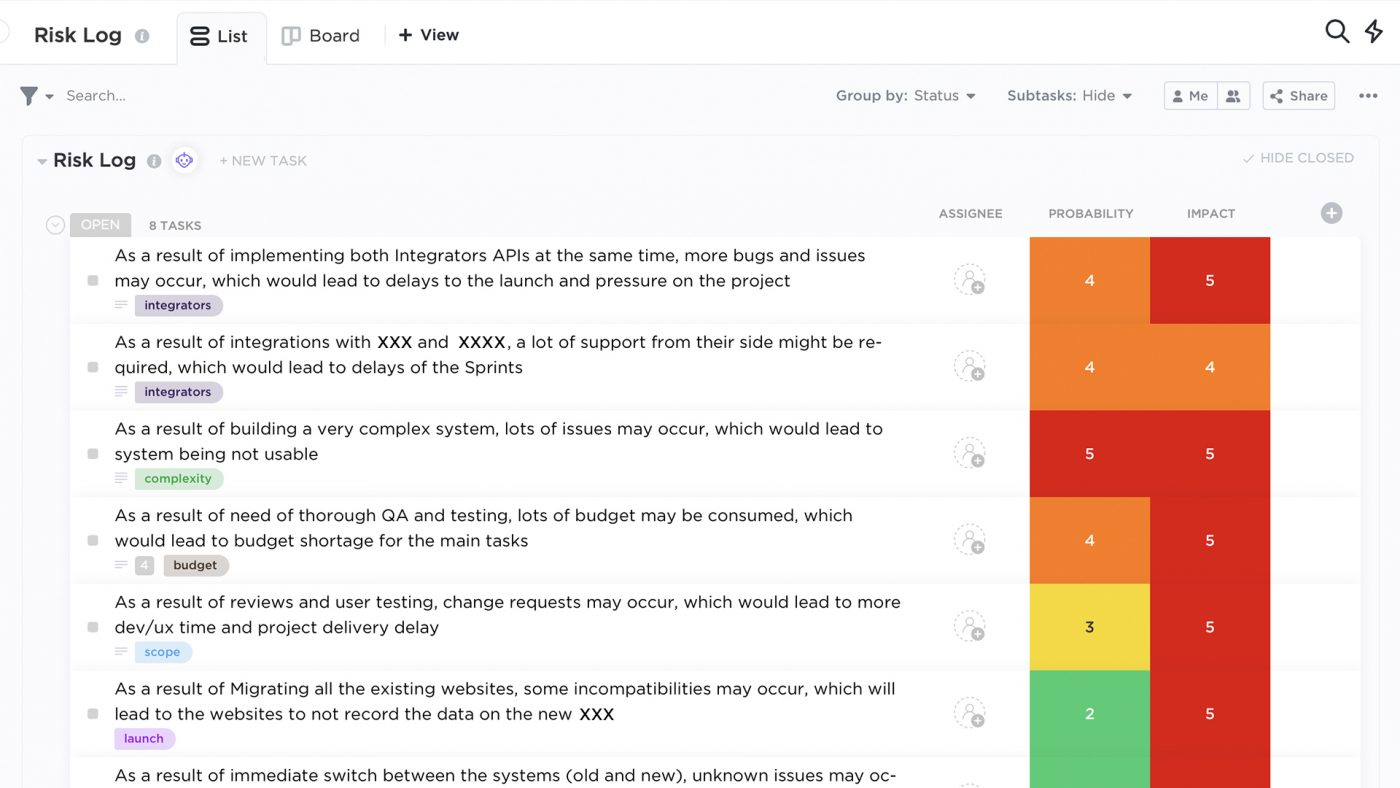
Using a Risk Log could seriously help you understand the impact and probability of your teams’ tasks (or your personal tasks) if they were incomplete. Understanding your potential risks could help you better understand your teams’ overall productivity.
Interview Question Pro Tip:
A common interview question is: How do you prioritize your work? Knock this question out of the park every time by showing the hiring manager your ability to think critically and strategically. Explain how you assess the importance and urgency of each task, and how you prioritize your workload based on those factors. Demonstrate your organizational skills and ability to manage multiple priorities simultaneously without getting overwhelmed.
6. Schedule all of your tasks and work assignments
Task scheduling must be an item in your project management checklist. It starts with defining a start and an end date for each task in your prioritized task list. And suits a few purposes, from adding the tasks to your calendar to managing workloads.
If you’ve already added a due date to each task, no problem! You actually need those as a reference for defining start and end dates.
You might want to finish one task before the due date to account for unanticipated delays. But let’s consider that your goal is to finish tasks at least by their due date.
Now, completing each task by the due date depends on your capacity. And it also depends on whether you have concurrent priorities. But you can only draw solid conclusions on your capacity and priorities after scheduling your tasks in your calendar.

By distributing the tasks throughout the days, you can track your progress against deadlines. And by “progress,” we mean the duration (number or percentage of days) left to the end date. However, if you log work in each one of your tasks, you can also track progress against effort (estimated in person-hours).
Visualizing your calendar is highly effective in figuring out whether you can take on more tasks. And if you’ve already hit your maximum workload, you will need the extra help (there’s only so many hours in a day).
To manage tasks and prioritize effectively, schedule everything including your personal tasks and both internal and external project tasks.
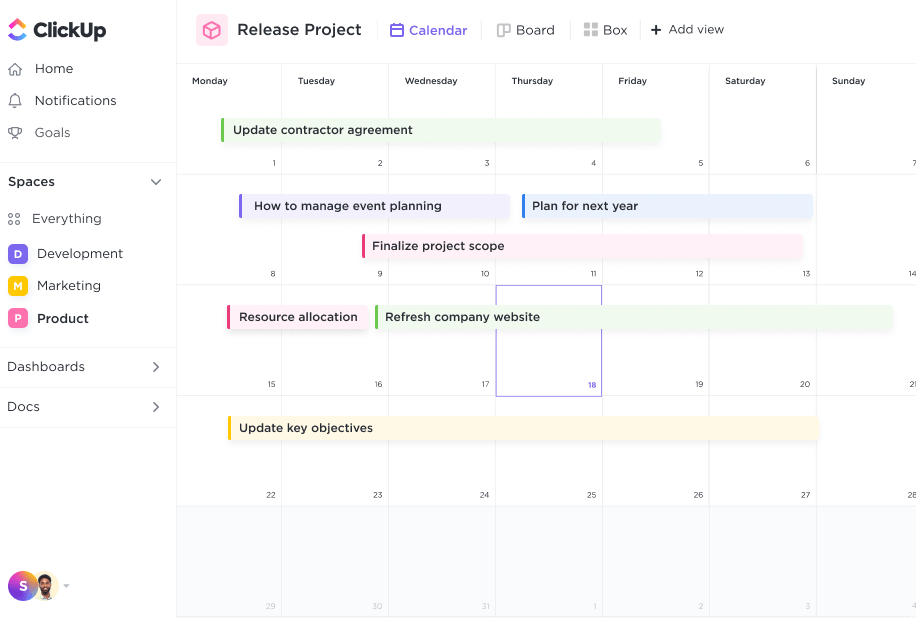
If you choose ClickUp, you’ll be able to schedule weekly meetings (and daily reminders) with recurring tasks. But you can go one step further by using ClickUp’s Calendar view to schedule your daily tasks (or weekly or monthly). And if you prefer a timeline or a table (or spreadsheet) view, ClickUp has those, too.
Finally, ClickUp contains a workload view to balance your workload like a charm. Spot days when you’re already, about to, or miles away from becoming overloaded. Then, act accordingly: Schedule more tasks in the latter case and shift tasks in the first case.
7. Block your time to get more work done
Schedule blocks of time to do your tasks uninterruptedly. This prevents you from multitasking, which is the opposite pole of task prioritization strategies.
Perform a project task within each one of those blocks of time or even a task that doesn’t belong to any project. You might also work on multiple tasks during a single block of time, but they must be small and unrelated tasks.
Signal blocks of time in your shared calendar as “focus time” and turn off notifications during that time. It’s a way for your peers and manager not to disturb you while you’re focused on completing your tasks, especially high-priority ones.
If you choose ClickUp to manage your tasks, consider using our time-blocking templates.
8. Communicate with your team as needed
Knowing how to prioritize tasks is one of the cornerstones for effectively working within a team. Or else, how could you loop in the team when they’re waiting for your work to start or finish theirs?
And how would they feel if you kept them waiting for your tasks’ completion indefinitely? You must give your teammates a heads-up whenever you experience a delay in your tasks’ progress. And tell them when you plan to complete those tasks.
You must also inform your manager of any blocker you bump into when performing your tasks. It’s their job to help you overcome those blockers.

ClickUp is excellent for sharing updates and following up by commenting on specific tasks. And those comments can include screen recordings that you can capture within the tool. Or you can assign comments to teammates to let them know you’re waiting on them to finish a task.
3 Time-Saving Work Prioritization Templates
The following ClickUp templates will leverage the theory behind the prioritization methods you just learned:
1. ClickUp ‘Getting Things Done’ Template
The ClickUp Getting Things Done Template is a comprehensive template to prioritize and track tasks in one place. It’s highly customizable with custom fields and even allows you to collaborate on documents with other team members.
Check out these GTD apps and GTD Templates!
You can use this task prioritization template to:
- Split tasks into categories—or contexts, according to the template—that you can build from custom fields
- Stay disciplined and prioritize tasks by context, due date, estimated duration, and effort level
- Schedule tasks in a calendar view
- Organize tasks in a customizable Kanban board by priority
2. ClickUp Impact Effort Matrix Template
If you’re running out of time to thoroughly assess your tasks’ priority, this template is just perfect! The ClickUp Impact Effort Matrix Template assists you in prioritizing tasks depending on the amount of effort needed to complete them.
For those that need to evaluate the impact or cost of a project quickly, this template helps you determine what should take priority. Align your team to understand what is most important to your collective team’s success with this visual template.
3. ClickUp Prioritization Matrix Template
We designed ClickUp’s Prioritization Matrix Template to prioritize your task list according to any two criteria you pick. For instance, categorize your tasks by significance and attainability levels, from low to high. Then, your high-priority tasks will be those with high significance and attainability.
Also, rely on colors to categorize tasks. For example, give a different color to tasks from various projects. This is a way to prioritize all your tasks from multiple projects in a single place.
Start Prioritizing Tasks to Optimize Your Workflow
This is our advice: Follow the task prioritization steps and methods in this guide. And then, move on to the next step and try out ClickUp, our task automation software solution.
Sign up for ClickUp today! Because knowing how to prioritize tasks is essential to reduce stress and stop working under pressure. But only when you automate tasks do you see the value behind a prioritized task list and ClickUp Tasks!




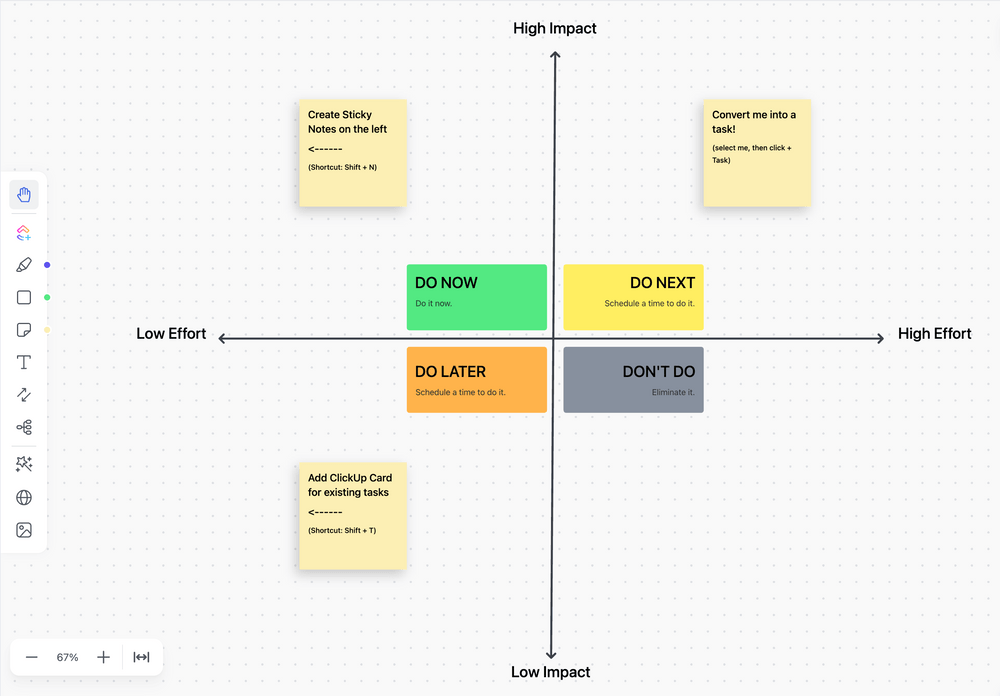

Questions? Comments? Visit our Help Center for support.